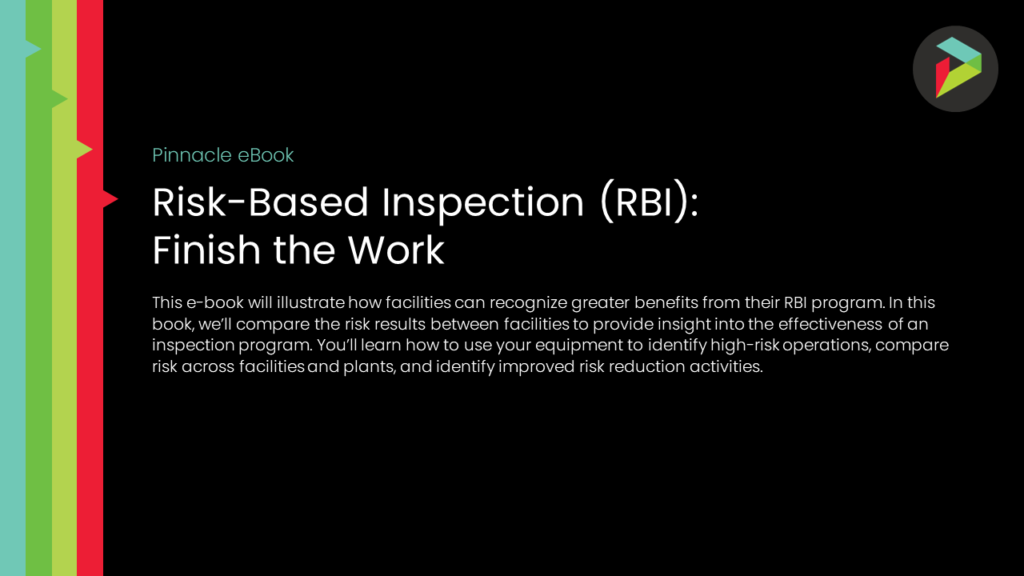We attended API’s 2024 Inspection and Mechanical Integrity Summit!
We had a great time at API’s 2024 Inspection and Mechanical Integrity Summit in San Antonio, Texas! Check out our presentations by clicking the links below:
- Demonstrating the Impact of a Quantitative Approach to CML Prioritization on Risk and Asset Availability
- Ensuring the Long-Term Sustainability of Your MI Program with a Data-Driven Approach
- Reducing HSE Risk and Increasing Production with the Next Level of RBI
- Using Data-Driven Fixed Equipment Health Models to Optimize Turnaround Planning and Spend
- How to Make Your Reliability Technology Work for You
- Take IOWs to the Next Level Using More Real-Time Models to Bring MI and Operations Together
- Using Risk-Based Data Mining to Collect Higher Quality Data Faster
- Case Study: Improving Quality Control with A Data Science Approach
- Combating the Complexity of PRD RBI and Recent Modifications in API RP 581 Methodology – Fourth Edition
- Panel: Piping Inspection Program Challenges and Improvement
Demonstrating the Impact of a Quantitative Approach to CML Prioritization on Risk and Asset Availability
Recent advancements in technology have improved the way facilities leverage data to identify the value of their condition monitoring locations (CMLs) placements. A data-driven approach to CML optimization can be used to identify where localized corrosion may be occurring, compare actual damage rate to expected corrosion rate, and determine whether existing inspection coverage can adequately identify suspected damage mechanisms. From this analysis, facilities can then identify areas where additional inspection or different inspection strategies are required. In this presentation, Pinnacle’s Lynne Kaley, Director of Reliability Strategy, will discuss how facilities can leverage a data-driven approach to prioritize CMLs more confidently, determine when additional data is required, and identify areas where facility risk and availability can be improved.

Lynne Kaley
Director, Reliability Strategy
Ensuring the Long-Term Sustainability of Your MI Program with a Data-Driven Approach
Whether you’re implementing a new program or working to improve your current one, setting your program up for success and securing champions in other departments is critical to ensuring the long-term sustainability of your program. A data-driven approach to reliability can help you overcome those key challenges. In this presentation, Michael Wallace and Sid Sanghavi, Partners at Pinnacle, will provide practical insights and tools for facilities to enhance the sustainability and performance of MI programs. Attendees will walk away with the tools they need to ensure long-term program sustainability and success.

Michael Wallace
Partner

Siddharth Sanghavi
Partner
Reducing HSE Risk and Increasing Production with the Next Level of RBI
While Risk-Based Inspection (RBI) has proved valuable to the industry, there is still a level of uncertainty associated with how long a facility’s assets will operate before failing. Quantifying this uncertainty can be challenging and requires a model that quantifies the impact of specific tasks on an asset’s probability of failure (POF) to determine which actions are the most effective in reducing uncertainty. In this presentation, Michael Wallace, Partner at Pinnacle, and William Minter, President at Pinnacle, will explore the limitations of traditional models, highlight the benefits of using a quantitative model, and present case study examples of how facilities leveraged a quantitative model to project future availability, minimize risk, and optimize costs.

Michael Wallace
Partner

William Minter
President
Using Data-Driven Fixed Equipment Health Models to Optimize Turnaround Planning and Spend
Turnaround planning involves selecting the right maintenance tasks that ensure maximum facility availability while appropriately controlling maintenance spend and duration. However, optimizing turnaround planning is difficult due to uncertainty concerning asset health. This uncertainty can be reduced dramatically through quantitative, data-driven modeling for fixed equipment health which helps facilities better drive turnaround scope, duration, and intervals. In this presentation, Pinnacle’s Ryan Myers, Product Manager, and Andrew Waters, Ph.D., Director, Data Science will demonstrate how facilities can leverage quantitative modeling to create a proactive maintenance approach that minimizes downtime and unnecessary maintenance costs. Attendees will walk away with a better understanding of how to optimize turnaround planning and spending to maximize return on investment (ROI), and reach the ideal balance between availability, risk, and costs.

Andrew Waters, PhD
Director, Data Science

Ryan Myers
Product Manager
How to Make Your Reliability Technology Work for You
From optimizing inspection tasks to planning turnaround maintenance, technology plays a critical role in your daily asset management decisions. However, despite the numerous technology packages that exist, many operators struggle to seamlessly integrate their systems together to create a strong data foundation. A data-driven approach to reliability helps operators digitize, organize, and analyze data so that they can drive strategic decision use cases. However, with the array of software packages, how do you know which one works best for you? In this presentation, Steve Flory, Manager of Technology Success at Pinnacle, and Lewis Makin, VP of Solutions & Marketing at Pinnacle, will discuss how to select, implement, and maintain software packages so you can extract better insights, sustain and scale operations, and attain your reliability goals.

Lewis Makin
VP, Solutions & Marketing

Steve Flory
Manager (Technology Success)
Take IOWs to the Next Level Using More Real-Time Models to Bring MI and Operations Together
Many owner/operators have implemented an integrity operating windows (IOW) program, and while valuable, these programs do not accomplish the intended objectives and become difficult to sustain over time. As a result, facilities often waste engineering and inspection resources struggling to analyze data and determine proper risk mitigating actions. In this presentation, Ryan Myers, Product Manager at Pinnacle, and Fred Addington, Principal of Corrosion Technology, will discuss how a data-driven approach can be used to dynamically model degradation through multivariate analysis, which enables more precise calculations of risk, more quantitative and streamlined engineering analysis, value-based alerts, and strategic decision-making such as balancing trade-offs between production and mechanical integrity.

Fred Addington
Principal of Corrosion Technology

Ryan Myers
Product Manager
Using Risk-Based Data Mining to Collect Higher Quality Data Faster
Modeling risk is foundational to a Risk-Based Inspection (RBI) methodology. However, collecting data, uploading it into risk modeling software, and validating the results can be a slow and tedious process, with most of the data feeding these programs wasted. With Risk-Based Data Mining, an RBI approach leveraging data science is applied to the data collection process, enabling facilities to focus their resources and prioritize inspection activities that impact the risk of their assets. In this presentation, William Minter, President of Pinnacle, and Davis Baker, Product Manager at Pinnacle, will discuss how Risk-Based Data Mining can help facilities effectively collect the data they need to increase operating time and run length, manage risk, and sustain continuous improvement efforts.

Davis Baker
Product Manager

William Minter
President
Case Study: Improving Quality Control with A Data Science Approach
Human subject matter experts (SMEs) bring a unique skill set to data analysis. However, with the immense amount of data available today, it can be challenging for humans to fully derive all the benefits of this data. Machine learning and artificial intelligence (AI) can help strengthen the natural limitations of human SMEs, resulting in faster data analysis and better insights. In this presentation, Kevin Birkby, Partner at Pinnacle and Mason Thomas, Corporate Reliability Leader at Marathon, will discuss how Marathon improved the accuracy of identifying records requiring PMI inspection for its refineries by leveraging a Natural Language Processing (NLP) method that processed and analyzed a large amount of data.

Kevin Birkby
Partner

Mason Thomas
Corporate Reliability Leader
Combating the Complexity of PRD RBI and Recent Modifications in API RP 581 Methodology - Fourth Edition
A recent Pressure Relief Device (PRD) study using the API RP 581 methodology was completed. This study focused on the value of taking a risk-based approach to inspecting PRDs in terms of cost and risk reduction and included updated calculations being released in the Fourth Edition of API RP 581. The risk-based approach enables facilities to optimize PRD inspection and test intervals. In this presentation, Steve Quillen, Manager at Pinnacle, and Carey Roberts, Turnaround Consulting Services (TCS) will present the results of case studies using the modified 581 approach to calculate probability of failure (POF), consequence of failure (COF), and risk to identify which PRDs require removal for inspection and testing during upcoming turnarounds.

Steve Quillen
Manager (Services)

Carey Roberts
Turnaround Consulting Services (TCS)
Panel: Piping Inspection Program Challenges and Improvements
Lynne Kaley will moderate a discussion focused on common IDMS data health challenges and the practical improvements facilities need to incorporate to increase their ability to confidently use CML data to drive inspection intervals, RBI analyses, data analytics, and assessments of potential local thinning.
The discussion will include:
- Assessing IDMS data health to identify and resolve data errors and anomalies
- Risk assessments, the best risk-based modeling approach
- Using data-driven approaches to identify potential local corrosion from existing data
- Quantitative evaluation of inspection coverage and confidence of detecting local damage if it is present
- Using different inspection methods and probabilities of detection to evaluate inspection confidence
- Using data from area inspection methods to assess local corrosion, quantify inspection confidence, and provide estimated minimum thickness in uninspected areas
Curious about the main takeaways and themes from the last API Inspection and Mechanical Integrity Summit? Check out our presentations from the 2022 Summit below:
Big Data in Mechanical Integrity: The Next Generation of Corrosion Models
Recent advances in technology have transformed the way the world uses data. “Big Data” has the potential to improve how we evolve our MI programs. Pinnacle recently completed a study comparing the accuracy of asset degradation rates predicted by a machine learning model to the rates predicted by human SMEs applying current industry standards.
The study found that the machine learning model was able to predict degradation rates and associated variability with a higher level of accuracy and reduced the mean absolute error by 38% compared to the subject matter expert estimation. In this presentation, presenters discuss the details of the study, how large data sets can be used to better predict asset degradation, and the challenges of making “Big Data” actually work.
Case Study: Increasing the Effectiveness of CML Optimization Through Condition Monitoring Optimization
While many facilities approach traditional CML Optimization with the elimination of CMLs in mind, the focus should first and foremost be on effective risk management and risk reduction. Condition Monitoring Optimization, a new, data-driven methodology by which inspection scope, techniques, and intervals are determined and dynamically
updated as new information is available, enables facilities to confidently prioritize CMLs and determine when additional data is required, inspection adds little or no value, or corrective maintenance is needed. In this presentation, the presenters walk through a case study where an energy company increased monitoring for select CMLs to reduce risk to prioritize inspection scope and intervals while also reducing near-term monitoring by about 50% on the rest of the population.
The Economics of Reliability: Leveraging Reliability as a Competitive Strategy in Refining, Mining, and Chemicals
While processing facilities spend $500 billion annually on reliability, many facilities struggle to measure the impact of reliability at their facility. Allocating more of your budget to reliability initiatives doesn’t necessarily result in more profitable operations, and the key to leveraging reliability as a competitive strategy is knowing where to
strategically optimize your costs and mitigate risk. In this presentation, Jeff Krimmel, PhD, Chief Strategy Officer, analyzes insights from Pinnacle’s Economics of Reliability Reports, a series of reports that explore the impact of reliability on global industries. The presentation provides an understanding of the operational and financial realities that shape the reliability of major global industries and how they can leverage reliability as a core competitive strategy at their facility.
The Challenge with Our Current Risk Models
In general, the oil and gas industry is risk averse. Given the serious economic, environmental, and societal consequences that can result from an incident, facility management is typically conservative in how they calculate risk and in how they make risk management decisions. However, facilities must accept some level of risk in order to operate; capturing this accurately is key if facility management is to understand their true risks as well as how to deploy limited
resources most effectively. Learn how to overcome these challenges by focusing on quality data, analyses, and decision-making processes
How to Eliminate Data Silos to Drive Better Decisions at Your Facility
Many industrial facilities have design, operations, process, asset condition, and risk model data stored in variety of different repositories, creating data silos. Regardless of whether the data is a hardcopy, stored in spreadsheets, or software, the solution is not simply integrating everything into one software. The key to
successfully leveraging your data is bringing your data together and properly contextualizing it to feed into the right models to drive better and faster mechanical integrity and reliability decisions. In this presentation, Lewis Makin, Partner, discusses the typical data challenges and how to approach solving them.
Observations and Tips for Reliability and Integrity Technologies
There are an array of Inspection Data Management, Risk-Based Inspection, and other reliability function software packages in the industry. This discussion focuses on common pitfalls themes, including which software packages are used, how they are implemented, and then maintained. Additionally, this presentation includes examples of
what not to do, what to look out for, and ultimately, how to make the right software work for you in attaining your reliability and mechanical integrity goals.

Risk-Based Inspection: Finish the Work
The Risk-Based Inspection (RBI) methodology presented in API RP 581 was developed as a method for using risk as a basis for prioritizing and managing the efforts of an inspection program. RBI programs help facilities increase operating times and run lengths while decreasing risk by shifting inspection and maintenance resources to focus on high-risk equipment while maintaining a lower level of
activity on low-risk equipment. Watch the presentation for a discussion about how facilities can recognize greater benefits from their RBI program and demonstrates how comparing risk results between facilities can provide insight into the effectiveness of an inspection program. Learn how to use equipment to identify high-risk operations, compare risk across facilities and plants, and identify improved risk reduction activities.
Reducing Lifecycle Spend by Leveraging Advanced Image Analytics in Asset Integrity Programs
There are an array of Inspection Data Management, Risk-Based Inspection, and other reliability function software packages in the industry. This discussion focuses on common pitfalls themes, including which software packages are used, how they are implemented, and then maintained. Additionally, this presentation includes examples of
learning technologies, we can effectively reduce safety risk by optimizing our field personnel and resources. Such technological advancement can help proactively monitor for damage, screen for anomalies, and detect additional defects. Learn how to effectively integrate digitization and advanced image analytics into a mechanical integrity program to lower safety risk, reduce lifecycle cost, and more proactively manage your facility.
Stay in the know.
Providing data-driven insights, perspectives, and industrial inspiration from the forefront of the reliability transformation.